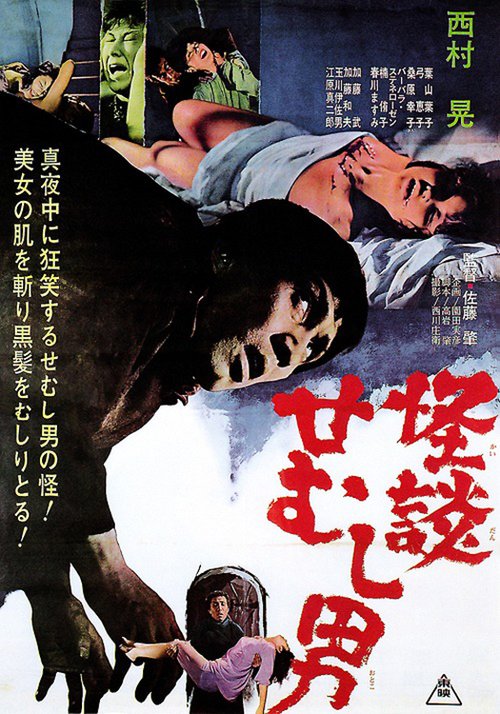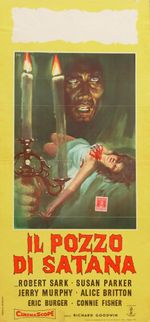Kaidan Semushi Otoko (found original audio from Japanese horror film; 1965): Difference between revisions
(This film is not lost, it is commercially available for purchase) |
No edit summary |
||
| (4 intermediate revisions by 3 users not shown) | |||
| Line 1: | Line 1: | ||
{{ | {{InfoboxFound | ||
|image=Semushi JP.jpg | |image=Semushi JP.jpg | ||
|imagecaption=Japanese advertising poster. | |imagecaption=Japanese advertising poster. | ||
|status=<span style="color:green;">''' | |status=<span style="color:green;">'''Found'''</span> | ||
}} | |datefound=10 Jan 2023 | ||
'''''Kaidan Semushi Otoko''''' (怪談せむし男), also known under the English titles ''The Ghost of the Hunchback'' and ''House of Terrors'', is a 1965 Japanese horror film produced and released by Toei<ref name="R1">Kinema Junposha K.K. ''via'' Eiga.com, http://eiga.com/movie/70270/</ref>. It stars Ko Nishimura, Yuko Kusunoki, Kazuo Kitamura and Shinjiro Ehara and was directed by Hajime Sato<ref name="R1" />. The plot concerns a woman, Yoshie Munakata (Kusunoki), who learns of her mentally ill husband's death that the man led a | |foundby=Toei | ||
}} | |||
'''''Kaidan Semushi Otoko''''' (怪談せむし男), also known under the English titles ''The Ghost of the Hunchback'' and ''House of Terrors'', is a 1965 Japanese horror film produced and released by Toei<ref name="R1">Kinema Junposha K.K. ''via'' Eiga.com, http://eiga.com/movie/70270/</ref>. It stars Ko Nishimura, Yuko Kusunoki, Kazuo Kitamura and Shinjiro Ehara and was directed by Hajime Sato<ref name="R1" />. The plot concerns a woman, Yoshie Munakata (Kusunoki), who learns of her mentally ill husband's death that the man led a double life in a remote and luxurious villa, tended by a hunchbacked caretaker (Nishimura) who is not what he seems to be. | |||
In 1966<ref>''Edizioni MCMLXVI'', Film poster</ref>, a year after the film was released in its native Japan, Kaidan Semushi Otoko was picked up for distribution by Filmar, an Italian company. Filmar changed the film's title to ''Il Pozzo di Satana'' (''Satan's Pit'') and produced a relatively faithful Italian-language dub, changing some of the principal characters' names. The Italian-language dialogue was written by Franco dal Cer. Filmar also added new titles to the film, giving the cast and primary crew English pseudonyms. | In 1966<ref>''Edizioni MCMLXVI'', Film poster</ref>, a year after the film was released in its native Japan, Kaidan Semushi Otoko was picked up for distribution by Filmar, an Italian company. Filmar changed the film's title to ''Il Pozzo di Satana'' (''Satan's Pit'') and produced a relatively faithful Italian-language dub, changing some of the principal characters' names. The Italian-language dialogue was written by Franco dal Cer. Filmar also added new titles to the film, giving the cast and primary crew English pseudonyms. | ||
The Filmar version of the film has been released | The Filmar version of the film has been released as a rare VHS, before the DVD of the Filmar version saw a release in October 2013<ref>CG Entertainment SRL, http://youtu.be/Ac2XTpMg5hE</ref>. The original Japanese version, with Japanese-language dialogue and titles, had since fallen into obscurity and was very hard to find until January 10th, 2023, when the original Japanese version of the film finally saw a home media release<ref>[https://amazon.com/House-of-Terrors-Blu-ray/dp/B0BP8GWW8M?tag=bluray-012-20&linkCode=ogi&th=1&psc=1&m=ATVPDKIKX0DER Blu Ray Listing on Amazon]</ref>. | ||
==Gallery== | ==Gallery== | ||
| Line 17: | Line 18: | ||
{{reflist}} | {{reflist}} | ||
[[Category: | [[Category:Found audio]] | ||
[[Category: | [[Category:Found films]] | ||
[[Category: | [[Category:Found media]] | ||
Latest revision as of 17:20, 14 April 2023
Kaidan Semushi Otoko (怪談せむし男), also known under the English titles The Ghost of the Hunchback and House of Terrors, is a 1965 Japanese horror film produced and released by Toei[1]. It stars Ko Nishimura, Yuko Kusunoki, Kazuo Kitamura and Shinjiro Ehara and was directed by Hajime Sato[1]. The plot concerns a woman, Yoshie Munakata (Kusunoki), who learns of her mentally ill husband's death that the man led a double life in a remote and luxurious villa, tended by a hunchbacked caretaker (Nishimura) who is not what he seems to be.
In 1966[2], a year after the film was released in its native Japan, Kaidan Semushi Otoko was picked up for distribution by Filmar, an Italian company. Filmar changed the film's title to Il Pozzo di Satana (Satan's Pit) and produced a relatively faithful Italian-language dub, changing some of the principal characters' names. The Italian-language dialogue was written by Franco dal Cer. Filmar also added new titles to the film, giving the cast and primary crew English pseudonyms.
The Filmar version of the film has been released as a rare VHS, before the DVD of the Filmar version saw a release in October 2013[3]. The original Japanese version, with Japanese-language dialogue and titles, had since fallen into obscurity and was very hard to find until January 10th, 2023, when the original Japanese version of the film finally saw a home media release[4].
Gallery
References
- ↑ 1.0 1.1 Kinema Junposha K.K. via Eiga.com, http://eiga.com/movie/70270/
- ↑ Edizioni MCMLXVI, Film poster
- ↑ CG Entertainment SRL, http://youtu.be/Ac2XTpMg5hE
- ↑ Blu Ray Listing on Amazon

